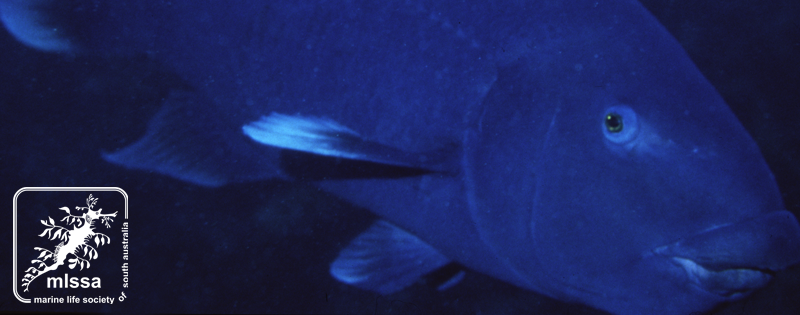
Western Blue Groper are a long-lived and slow growing fish, taking 15 years to reach sexual maturity at 60 cm which is the minimum size they may be taken under the existing rules. They live for up to 70 years to reach a maximum size of 1.6 m. (e.g. so therefore juvenile “parrotfish” that are caught and used for bait do not have a chance to reproduce, nor do sub-adults caught on deeper reefs).
Western Blue Groper used to be common as throughout Investigator Strait, and on the southern coast of Yorke Peninsula, but adults have not been seen on southern Yorke Peninsula since the 1960s when they were fished out. They still occur on northern KI due to their protection in the gulfs.
Western Blue Groper have a strong population structure and they change sex with age so fishing can disrupt population structure and dynamics.
Given its longevity and diet, Western Blue Groper may be a “keystone” species in the reef habitats where it occurs, and there may be ecological cascade effects from the extirpation of groper from reefs.
The questions regarding protection of the Western Blue Groper raise welfare issues which have been considered extensively in recent years, and has been well reviewed in Huntingford et al. (2006) J. Fish Biol. 68, 332-372.
It was concluded that conditions that produce unacceptable levels of anxiety, fear, stress, sickness and pain for the fish should be minimised.
Although there is a closure to Western Blue Groper fishing in South Australia’s Gulfs, Investigator Strait and a number of small Aquatic Reserves, it appears that this is insufficient as a means of protecting Western Blue Groper in South Australia, because:
- the species does not occur in the upper and most of the central parts of either gulf due to lack of suitable habitat and oceanographic conditions, and therefore only a small part of the species range in S.A. is formally protected;
- some fishers appear not to adhere to the prohibition of fishing for Western Blue Groper in Investigator Strait, or offshore reefs and islands within the closed area, the S boundary of which spans from western KI to southern Eyre, and illegal catches appear not to be monitored;
- there has been increased targeting of this species in offshore areas during the past decade, particularly by charter boats operating off the central and western coasts of S.A.; and
- some reef fishers do not recognise juvenile Western Blue Groper when they are caught as bycatch, and small specimens are thus retained for use as bait.
Actions needed to overcome the identified threats include:
Legislative protection – there is a clear need for the extension of the current protection for these fish. This could include listing as endangered under the EPBC Act (1999) and the National Parks and Wildlife Act as well as extension of current protection under the Fisheries Act to cover all State waters.
The size limit on Western Blue Groper be abolished so all caught fish must be returned to the sea.
The catching and photographing of “trophy” fish be banned, as the fish is exposed to the air for unacceptable amounts of time and their protective slime coating would be damaged by this increased handling.
Increased and maintained research and monitoring for the species such as the Reef Watch ‘Feral or in Peril’ programme. (Western Blue Groper are currently one of the ‘in peril’ species targeted by this programme).
Reduction and mitigation of human impacts on the marine environment and reef habitat in particular, i.e. sedimentation, excess nutrient inputs and other pollution.
Actions and education to encourage compliance with current size and catch limits, in particular the issue of non or misidentification of juveniles by anglers needs to be addressed.
Actions to avoid and reduce bycatch of this species. For example pot and trap designs that reduce the bycatch of fish should be encouraged
The use of Western Blue Groper as cray pot bait should be prohibited by regulation under the Fisheries Management Act (2007).
A number of Western Blue Groper ‘hotspots’ for both adult and juvenile fish have already been identified and these need to be protected in marine park sanctuary zones. Marine parks in conjunction with improved marine planning can also help address climate change impacts.

[…] Western Blue Groper […]
Saw a blue groper 10 to 15 kilo south west of Balgowan this weekend 3rd February 2019 in 14 metres. Captured on video.
This weekend just gone (3rd February 2019) I saw a 10 to 15 kg blue groper in 13 metres, southwest of Balgowan, Spencer Gulf. I have dived this area for over 50 years and while seeing the odd green juvenile, this is the first groper of this size I have seen in these waters. The bottom was rugged with kelp, two metre ledges and holes. I have video footage.
That’s great news, Stuart. Thanks for reporting your sighting. Is your video footage available to view?
I find it difficult to believe your statement about blue groper not being seen off southern York Peninsula since the1960s. That is not true. I dived in that area in the 1970s and 80 s around Cape Spencer Reef,Reef Head, Pondalowie Bay Althorpe Is ECT . Plenty of blue groper. Protected now in the area. They would to still be there.I live in Port Lincoln commercial abalone fishing 42 years. Blue Groper one of the most common species seen.
Fair enough Greg.
The statement was meant in a generalist context but was misleading I agree.
I too have seen Blue Groper off southern Yorke Peninsula during the last decade.
However the species is rare there as adults of breeding age, and seeing the occasional mature one in the area does not equate with the species being common there. Instead we must accept the available science,which shows that these fish are functionally extinct in GSV and threatened in SG.
The fact that they are a protected species in the gulfs is the main problem.
Unfortunately for the species to recover anything like the population densities it had a century ago (when it was common for shore based recreational fishers to land large males directly from cliffs and rock platforms around Pondalowie Bay and surrounding areas using heavy duty gear baited with abalone and reeling them up very quickly to prevent them wedging themselves in caves and crevices and ‘escaping ‘ ie left to die with the trace caught firmly around rocks etc) it needs full state wide protection.
You may have more faith in human nature than me, but I have seen this top order reef-associated territorial scale fish decimated by humans in GSV over my lifetime.
I’ve never been an abalone diver but have dived with a few of those, starting at Elliston when I was about 20 years old.
As for this species being common around Port Lincoln, I disagree. Common is a subjective term.
They’re still sufficiently present to be noticed on most dives, as immature ones definitely and not uncommonly as mature ones, but you and I both know that they are very inquisitive, so someone who is underwater for the long periods you spend will always attract the biggest males who will check you out on every occasion.
The reefs just within lower SG such as around the Sir Joseph Banks group are almost devoid of mature Blue Groper. That was very obvious to me during a roughly 1 week dive trip to the group with Pirsa Sardi and Dewnr in 2009.Nobody saw any mature ones and only a few immature ones were seen at all (I saw a few, but most dives I saw none, and I was searching for them).
When I flew there for a day’s spearfishing at age 17 ((I’m 67) we had to virtually push them aside to get a clear shot at the species we were targeting (we were very limited as to what the eskies weighed for taking off!)
This species needs full protection in all state waters not only the gulfs.
Cheers
David
Hey Steve Reynolds,
We really need to edit several key parts of this article.
I don’t know how, so let’s discuss it together at a mutually convenient time.
A few key points that are missed or misleading are:-
#1:Large adults have not often seen by recreational divers on southern Yorke Peninsula since about the late 1960s.
#2: It’s wrong to say the species doesn’t occur in most of upper and mid Gulfs. Smaller juveniles have always been seen and still are, in suitable rock reef terrain (terrain which is more and more limited in area the further up the Gulfs we go).
Mature Groper don’t now occur in the upper GSV ,and must be very rare mid GSV, but it seems likely that mature ones did occur quite commonly mid GSV pre settlement, eg Aldinga and Noarlunga.
Immature Groper are often seen at Aldinga, Noarlunga etc but they never reach maturity so we’re not going to see big males on those popular dive sites, ever, until the species is protected state wide and rock reef GSZ sizes and numbers are increased in mid to upper GSV .
#3: the bit about catch and release seems a bit out of main context for the article and perhaps could be omitted?
Just some preliminary thoughts.
Cheers,
David Muirhead